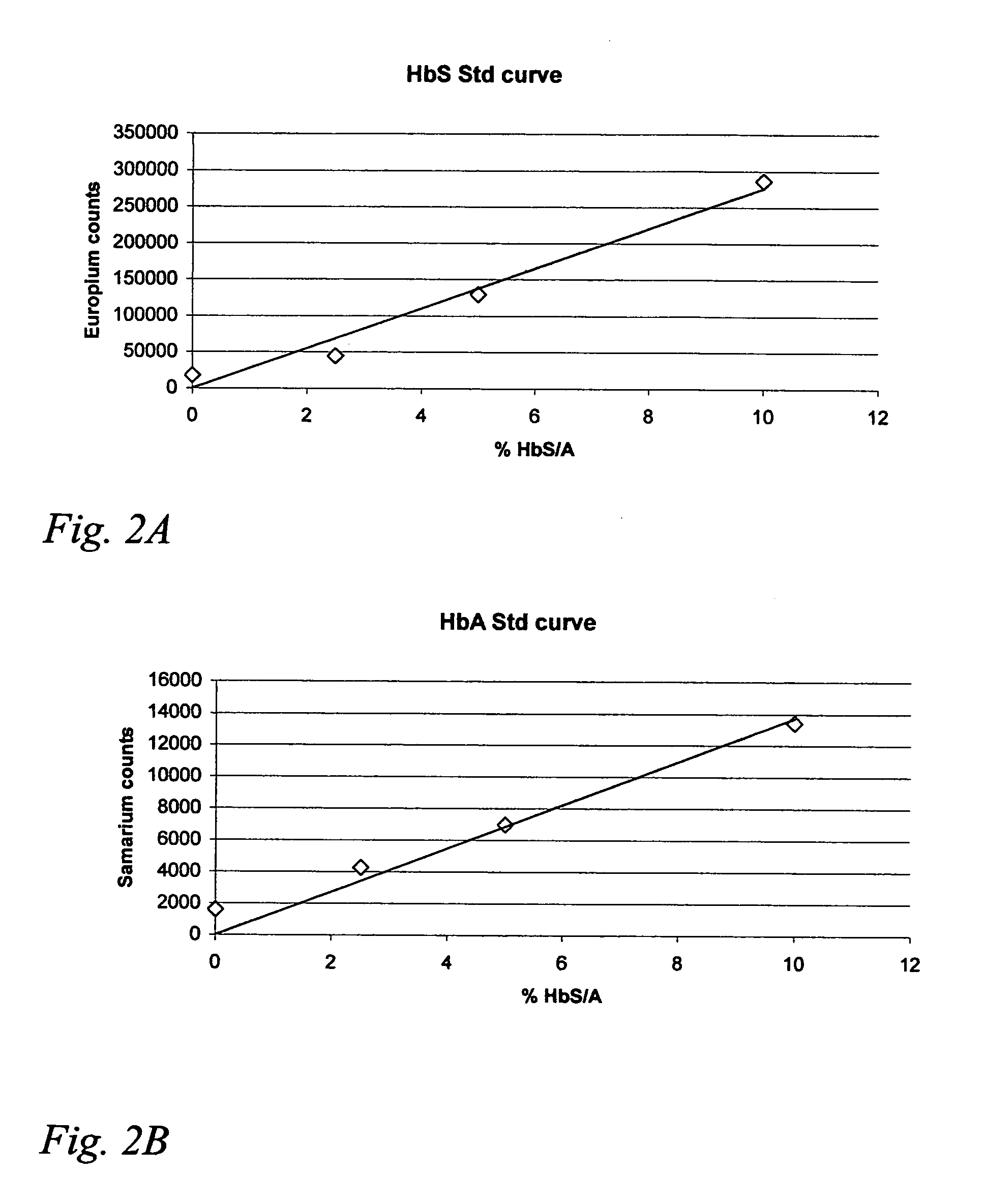Hemoglobin assay for neonatal screening
a technology of hemoglobin and neonatal screening, which is applied in the direction of chemical methods analysis, material testing goods, biochemistry apparatus and processes, etc., can solve the problems of not being suitable for universal routine neonatal screening, labor-intensive and expensive isoelectric focusing or hplc, and suffering from severe anemia, so as to avoid contamination of umbilical cord blood by maternal blood, simple methods, and simple sample handling
- Summary
- Abstract
- Description
- Claims
- Application Information
AI Technical Summary
Benefits of technology
Problems solved by technology
Method used
Image
Examples
example 1
Labelling of Anti-HbA Antibody
[0053] Sm-N1 chelate was obtained from Wallac Oy, Turku, Finland. An anti-HbA antibody (PerkinElmer Life and Analytical Sciences, Akron, USA) at the concentration of 7.0 mg / mL was incubated with a 100-fold molor excess of the chelate in 50 mmol / L carbonate buffer, pH 9.5, overnight at +4° C. Labelled antibody was then separated from unreacted chelates by gel filtration (Protein G Sepharose) with the buffer containing 50 mmol / L Tric-HCl, pH 7.75, containing 9 g / L NaCl as elution buffer. The labelling degree (Sm3+ / IgG) was determined by measurement of the Sm3+ concentration of conjugated antibody against a Sm3+ calibrator with a DELFIA system. The labelling degree of 9.7 was achieved. Labelled antibody has been found stable for several months when stored at +4° C. in Tris buffer, pH 7.4, containing bovine serum albumin as a stabilator (0.1%).
example 2
Labelling of Anti-HbS Antibody
[0054] Eu-N1 chelate was obtained from Wallac Oy, Turku, Finland. An anti-HbS antibody (PerkinElmer Life and Analytical Sciences, Akron, USA) at the concentration of 2.4 mg / mL was incubated with a 100-fold molor excess of the chelate in 50 mmol / L carbonate buffer, pH 9.5, overnight at +4° C. Labelled antibody was then separated from unreacted chelates by gel filtration (Protein G Sepharose) with the buffer containing 50 mmol / L Tric-HCl, pH 7.75, containing 9 g / L NaCl as elution buffer. The labelling degree (Eu3+ / IgG) was determined by measurement of the Eu3+ concentration of conjugated antibody against a Eu3+ calibrator with a DELFIA system. A labelling degree of 11.5 was achieved. Labelled antibody has been found stable for several months when stored at +4° C. in Tris buffer, pH 7.4, containing bovine serum albumin as a stabilator (0.1%).
example 3
Coating of Microtitration Plates with Anti-Hb Alpha-Chain Antibody
[0055] Microtitration strip wells (Nunc IMMUNO STRIPS C 12 irradiated, type 4-77178) were coated with anti-Hb alpha-chain antibody (PerkinElmer Life and Analytical Sciences, Akron, USA), 1.0 μg antibody per well (in 0.2M Na2HPO4 / 0.2M NaH2PO4), at 37° C. in overnight incubation at pH 7. The coated strips were blocked by incubating with saturation buffer (50 mM NaH2PO4 containing 3% trehalose, 0.1% Germall II, and 0.1% bovine serum albumin) for overnight at room temperature (˜22° C.), then aspirated and dried for at least overnight at 37° C. Air-tightly packed coated microtitration plates have been found stable for several months when stored at +4° C.
PUM
| Property | Measurement | Unit |
|---|---|---|
| pH | aaaaa | aaaaa |
| pH | aaaaa | aaaaa |
| concentration | aaaaa | aaaaa |
Abstract
Description
Claims
Application Information
 Login to View More
Login to View More - R&D
- Intellectual Property
- Life Sciences
- Materials
- Tech Scout
- Unparalleled Data Quality
- Higher Quality Content
- 60% Fewer Hallucinations
Browse by: Latest US Patents, China's latest patents, Technical Efficacy Thesaurus, Application Domain, Technology Topic, Popular Technical Reports.
© 2025 PatSnap. All rights reserved.Legal|Privacy policy|Modern Slavery Act Transparency Statement|Sitemap|About US| Contact US: help@patsnap.com


